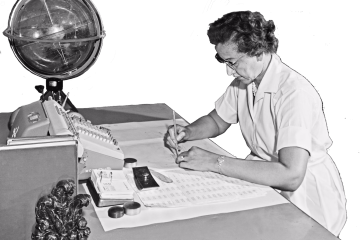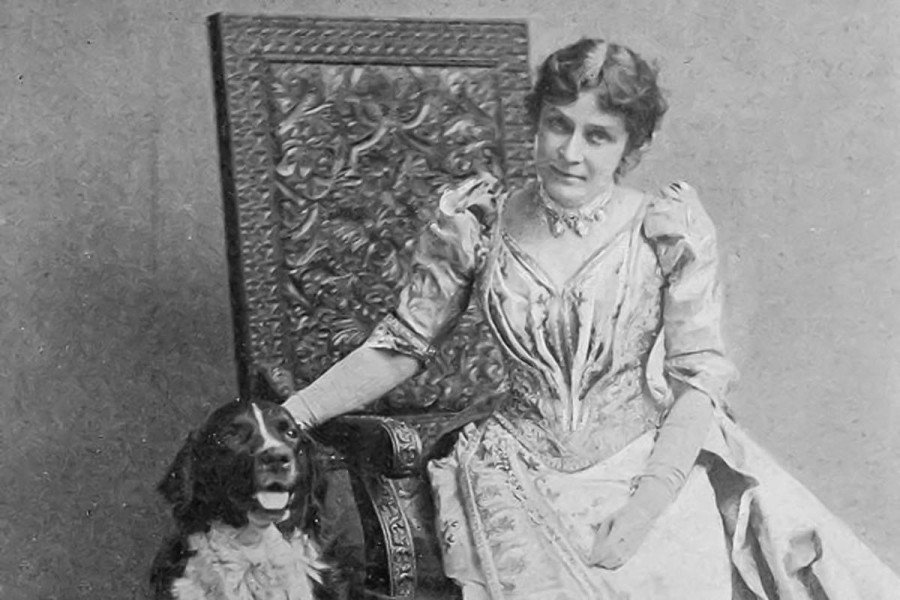Women in STEM, past and present
Travel back in time to uncover the innovations of women in STEM and reflect on how we can honor and encourage women in STEM today.
- Grades 8-10
- 3 activities
- 2.2 hours

Big idea
Through thought provoking activities and critical thinking, students learn about women in STEM in history and now, learn about Eunice Foote and greenhouse effect, conduct an experiment to confirm her findings and explore STEM careers for all.
For a Grade 5 version, see Women in STEM, then and now.
Learning objectives
- Demonstrate understanding of the achievements and challenges that many historical women in STEM faced.
- Demonstrate ability to conduct the experiment following instructions, observing and interpreting the results.
- Demonstrate comprehension of greenhouse effect and climate change.
- Demonstrate engagement and focus exploring STEM careers and creating a job posting
Activities
BC curriculum fit
Social Studies 8 -10
Big idea
- Human and environmental factors shape changes in population and living standards. (Gr. 8)
- Emerging ideas and ideologies profoundly influence societies and events. (Gr. 9)
- The development of political institutions is influenced by economic, social, ideological, and geographic factors. (Gr. 10)
- Historical and contemporary injustices challenge the narrative and identity of Canada as an inclusive, multicultural society. (Gr. 10)
Content
- Scientific and technological innovations (Gr. 8)
- Political, social, economic, and technological revolutions (Gr. 9)
- Environmental, political and economic policies (Gr. 10)
- Discriminatory policies and injustices in Canada and the world (Gr. 10)
- Advocacy for human rights (Gr. 10)
Curricular Competencies
- Use Social Studies inquiry processes and skills to ask questions; gather, interpret, and analyze ideas; and communicate findings and decisions (Gr. 8-10)
Science 9
Big idea
- The biosphere, geosphere, hydrosphere, and atmosphere are interconnected, as matter cycles and energy flows through them. (Gr. 9)
- Energy is conserved, and its transformation can affect living things and the environment. (Gr. 10)
Content
- Matter cycles (Gr. 9)
- Sustainability of systems (Gr. 9)
- Local and global impacts of energy transformations from technologies (carbon dioxide output) (Gr. 10)
Curricular Competencies
Questioning and Predicting
- Demonstrate a sustained [intellectual - Gr. 10]curiosity about a scientific topic or problem of personal interest. (Gr. 9-10)
Planning and Conducting
- Select and use appropriate equipment, including digital technologies, to systematically and accurately collect and record data. (Gr. 9-10)
Evaluating
- Evaluate their methods and experimental conditions, including identifying sources of error or uncertainty, confounding variables, and possible alternative explanations and conclusions (Gr. 9-10)
Career Education 8 & 9
Big ideas
- Reflecting on our preferences and skills helps us identify the steps we need to take to achieve our career goals. (Gr. 8-9)
- Our career paths reflect the personal, community, and educational choices we make. (Gr. 8-9)
Content
Personal Development
- Self-assessment for career research (Gr. 8-9)
Connections to Community
- Local and global needs and opportunities (Gr. 8-9)
Curricular Competencies
- Question self and others about how individual purposes and passions can support the needs of the local and global community when considering career choices. (Gr. 8-9)
- Recognize and explore diverse perspectives on how work contributes to our community and society. (Gr. 8-9)
- Appreciate the value of a network of resources and mentors to assist with career exploration. (Gr. 8-9)
Career Life Education 10 (CLE)
Big ides
- Career-life choices are made in a recurring cycle of planning, reflecting, adapting, and deciding.
Content
Career-life development
- Self-assessment and reflection strategies
Connections to Community
- Inclusive practices, including taking different worldviews and diverse perspectives into consideration
Curricular Competencies
Examine
- Examine the influences of personal and public profiles on career-life opportunities
Experience
- Identify career-life challenges and opportunities, and generate and apply strategies
Initiate
- Explore and reflect on career-life roles, personal growth, and initial planning for preferred career-life pathways.
Assessments
Learning Objective | Emerging | Developing | Proficient | Extending |
| Demonstrate understanding of the achievements and challenges that many historical women in STEM faced. | Demonstrates confusion around the achievements of women in STEM in history. | Correctly recalls 1-2 examples of the achievements of women in STEM in history. | Identifies examples of the achievements of women in STEM in history and explains why often men were credited for women's achievements. | Identifies examples of the achievements of women in STEM in history, explains reasons why often men were credited for women's achievements and shares how this would make them feel. |
| Demonstrate ability to conduct the experiment following instructions, observing, and interpreting the results. | Able to follow experiment instructions, but demonstrates some confusion observing and interpreting the results. | Able to follow experiment instructions and make basic observations, but may demonstrate some confusion interpreting the results. | Able to follow experiment instructions, make insightful observations and interpret the results. | Able to follow experiment instructions, make accurate predictions and insightful observations and interpret the results on a deeper level beyond the experiment. |
| Demonstrate comprehension of greenhouse effect and climate change. | Demonstrates some confusion of greenhouse effect and climate change. | Demonstrates basic comprehension of greenhouse effect and climate change. | Demonstrates comprehension of greenhouse effect and climate change and explains how the gases in the atmosphere contribute. | Demonstrates comprehension of greenhouse effect and climate change, explains how gases in the atmosphere contribute, and can identify several mitigation opportunities. |
| Demonstrate engagement and focus exploring STEM careers and creating a job posting. | Struggles to focus and demonstrates some engagement while exploring STEM careers. Shows some confusion creating a job posting. | Able to focus and demonstrate some engagement while exploring STEM careers and can create a basic job posting. | Demonstrates engagement and focus exploring STEM careers and creates a satisfactory job posting. | Clearly demonstrates strong engagement and focus exploring STEM careers and creates an exceptional job posting, and draws personal connections to at least one STEM career field they researched. |
Background info
These teaching notes contain more information on the following topics:
Historical women in STEMCheck out the following links to learn about the historical achievements of women in STEM:
According to Viterbi Conversations in Ethics, a forum for discussing engineering ethics published by the Viterbi School of Engineering at the University of Southern California, some examples of women’s work being credited to men include:
According to “Erasing women from science? It is called the Matilda Effect” accessed on JSTOR Daily, a publication that provides analysis on current events, research and ideas:
Here is a list of what the History Channel calls Nine Groundbreaking Women Inventors:
Celebrate Women and Girls in your classrooms:
Eunice Foote and greenhouse effectAccording to the American Physical Society, in 1856 Eunice Newton Foote concluded that carbon dioxide could warm the atmosphere, three years before John Tyndall did. In 1856, Foote conducted a series of experiments, using cylinders each with a thermometer inside, and each filled with different gases and gaseous mixtures — moist air, dry air, carbon dioxide, oxygen, and hydrogen, then placed them in the sun and charted how the gases warmed. The cylinder containing carbon dioxide warmed the most, she noted, and stayed at its high temperature for a long time after she took it out of the sun. United Nations: Actions for a healthy planet
BC Hydro’s Electrification PlanB.C. is powered by water In B.C., we have a unique advantage. The province’s natural landscape has allowed us to generate and deliver clean, renewable power to our customers for decades. And as we look to the future, we have an ambitious goal to do more. Our plan to electrify B.C. We’ll be instrumental in building a sustainable economy in B.C. We’ll continue to support conservation efforts, while also offering new programs and incentives to help British Columbians make the switch from fossil fuels to clean hydroelectricity to power their homes, businesses, and vehicles. We’ll also help to attract new energy-intensive industries to B.C. and offer programs to reduce the time and costs for new customers to get connected to our grid. Our goal is to reduce greenhouse gas emissions in the province by 900,000 tonnes per year by April 2026 – that’s around the same as taking 200,000 gas-powered cars off the road for one year. Our Electrification Plan outlines how we’ll get there. Women and girls in STEM todayInternational Day of Women and Girls in Science According to the United Nations, women are typically given smaller research grants than their male colleagues and, while they represent 33.3% of all researchers, only 12% of members of national science academies are women.
According to Randstad, one of the top employment agencies in Canada, here is a look at women in STEM careers in 2023:
UN Secretary-General Guterres calls for more empowerment for women and girls:
The STEMforGIRLS site is a resource for educators and students including featuring many female role models working in STEM fields. |




